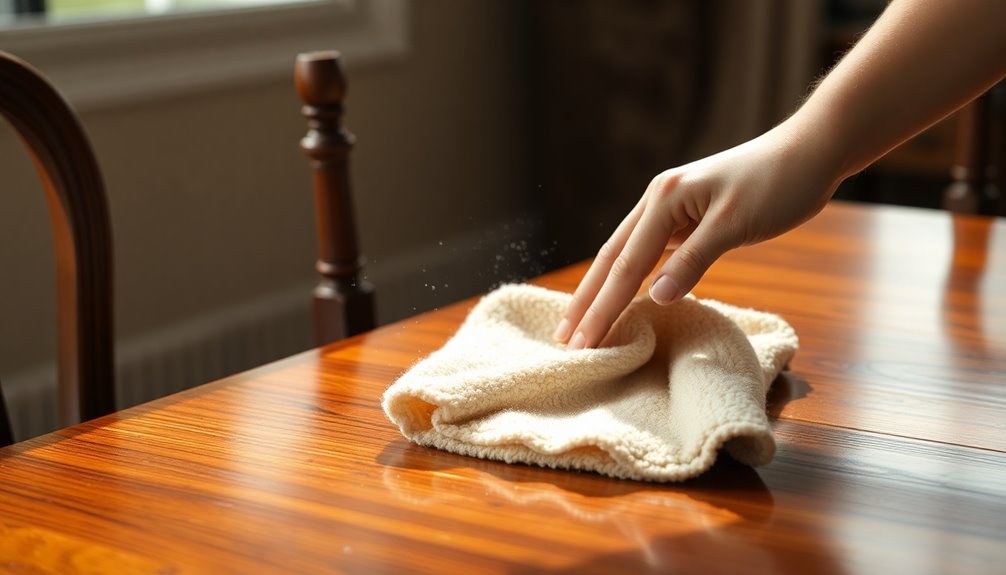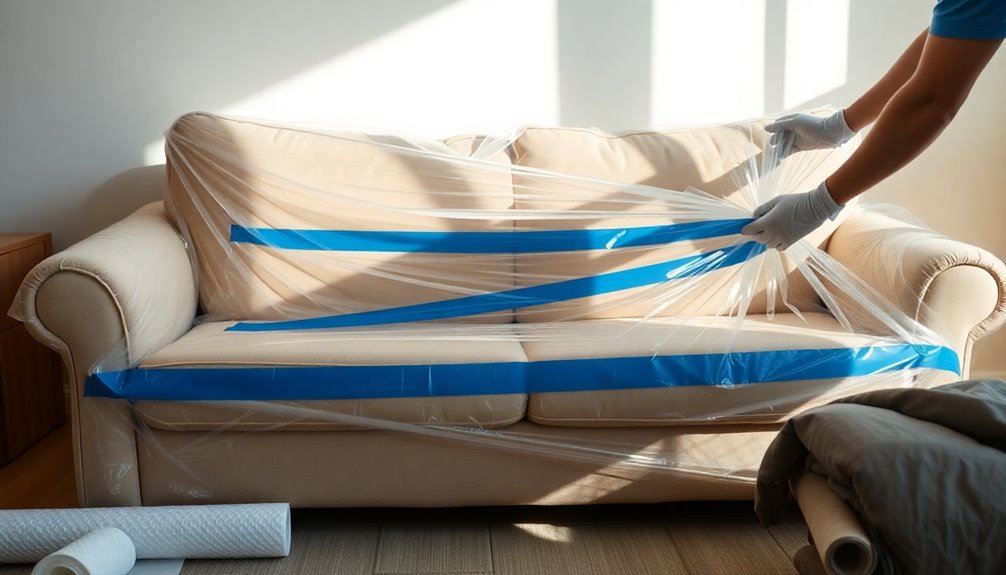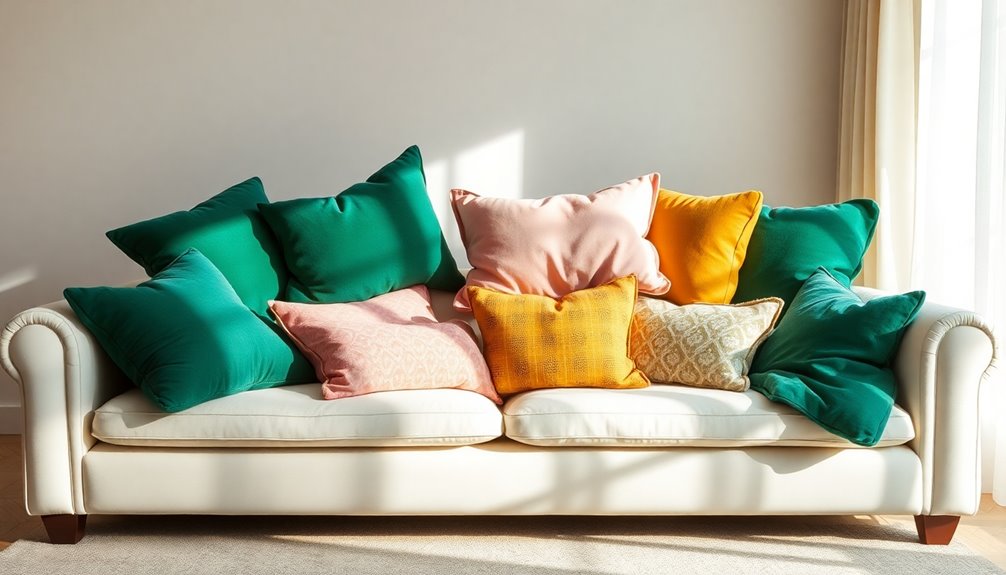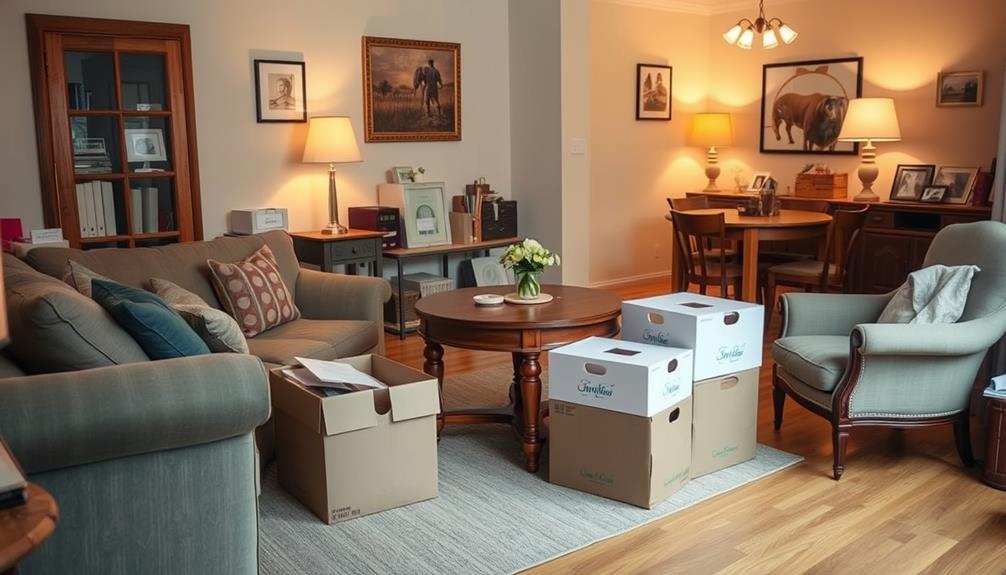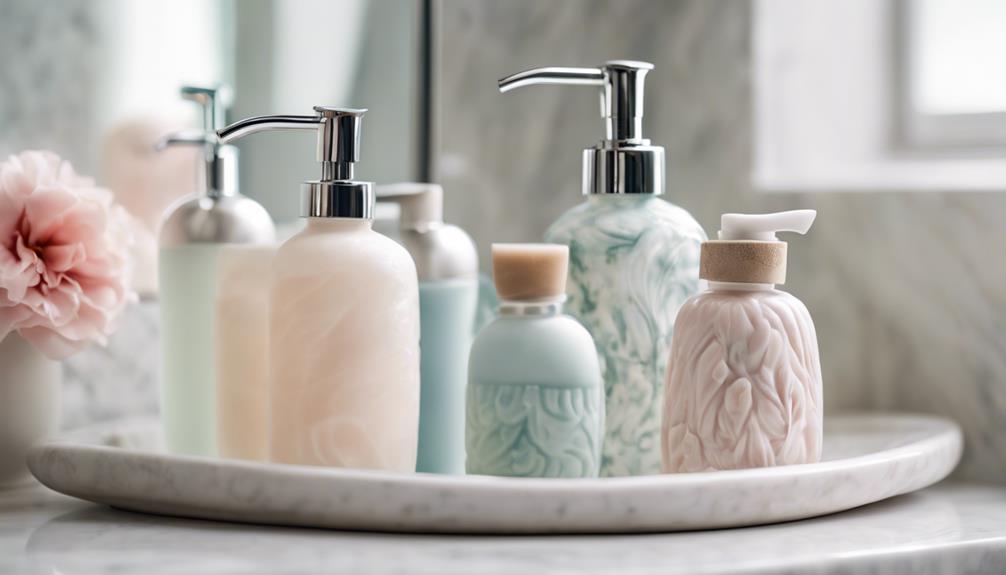To dust furniture, start by clearing surfaces of items so you can reach every corner. Use microfiber cloths or dusters to effectively trap dust. Remember to dust high surfaces first and work your way down. For wooden furniture, wipe with the grain to avoid scratches and streaks. Consider using a natural cleaning solution like vinegar mixed with water for added cleaning power. Establish a routine—dusting weekly can help keep allergens at bay and preserve your furniture’s appearance. Looking for tips on tools or special care techniques? There’s more valuable information waiting for you. Additionally, checking regularly for pests can be an essential part of furniture maintenance. If you’re concerned about infestations, knowing how to spot bed bugs in furniture is crucial. Look for small, reddish-brown stains or tiny eggs in crevices, especially in upholstered items, to catch any problems early and ensure your home remains a safe and comfortable space.
Key Takeaways
- Start by clearing surfaces of items to access all areas effectively before dusting begins.
- Use microfiber cloths or dusters to capture dust without redistributing it back into the air.
- Dust from high surfaces to low, following a systematic approach for thorough coverage.
- Utilize natural cleaning solutions or specialized dusting polishes for wooden furniture to nourish and protect.
- Schedule regular dusting sessions, adjusting frequency based on the dust levels in your home.
Choosing the Right Dusting Tools
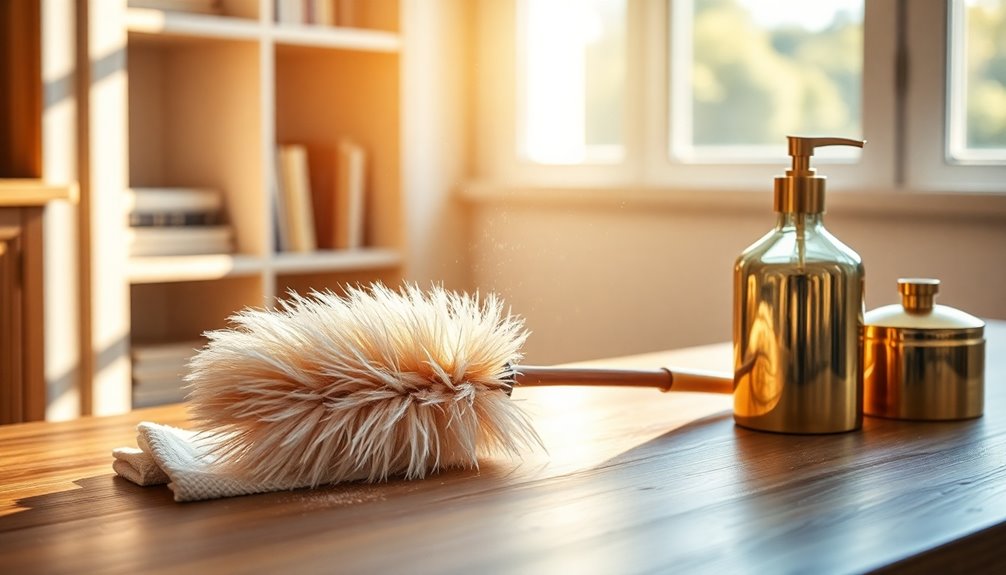
When it comes to dusting furniture effectively, selecting the right tools can make all the difference. Microfiber cloths are a must-have; their fine fibers trap dust particles efficiently, and they're washable and reusable, making them eco-friendly. Use them on most furniture surfaces, with or without dusting sprays.
For hard-to-reach areas, consider microfiber dusters. They attract dirt like a magnet, capturing 99% of dust and bacteria. You can attach them to telescopic poles for those high spots, and they're perfect for delicate surfaces like crown molding and bookshelves. Regular dusting not only enhances cleanliness but also improves air quality in your home.
Dusting brushes are great for delicate items, too. Their soft, flexible bristles won't scratch intricate surfaces, and many come with extendable handles for added reach.
If you want specialized options, try Swiffer 360 Heavy Duty Dusters for comprehensive cleaning, or the OXO Good Grips Microfiber Hand Duster for detailed work on blinds and furniture. The DocaZoo DocaPole Dusting Kit is excellent for high-reach areas, while the Unger Microfiber Ceiling Fan Duster makes cleaning fan blades a breeze. Choose the right tools, and you'll make dusting a lot easier!
Preparing for Dusting
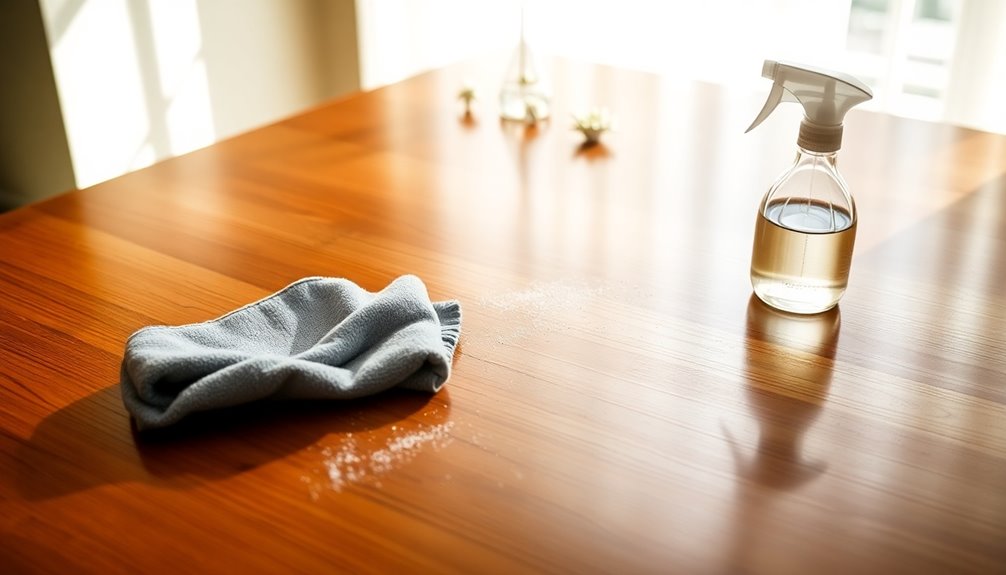
Preparing for dusting is crucial for achieving the best results. Start by removing all items from the furniture surface. This includes objects, books, and any other belongings that could obstruct your access. Next, check for any stains or greasy spots and gently wipe them off with a soft cloth. If you plan to use a cleaning solution, test it in an inconspicuous area to ensure it won't damage the finish.
Take a moment to inspect the area for potential hazards, like loose cords or unstable furniture, and clear the surrounding spaces to minimize dust spread. Vacuum or sweep the floor around the furniture to eliminate dust that could settle back onto cleaned surfaces. Regularly addressing dust accumulation can help prevent warping, cracking, and mildew growth in your furniture. Additionally, consider scheduling regular maintenance to keep your furniture in optimal condition.
Before you begin, consider wearing personal protective equipment, such as gloves and masks, to shield yourself from dust and debris. If the cleaning area is large or complex, working in pairs can enhance safety. Lastly, ensure all your dusting tools are in good condition and ready for use. By following these steps, you'll set yourself up for an efficient and effective dusting session.
Dusting Techniques
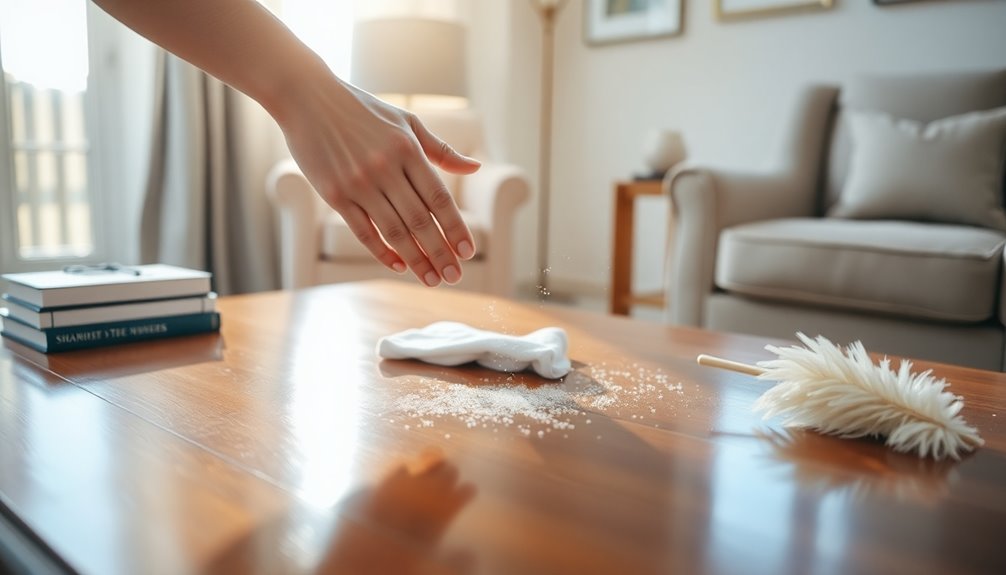
Often, effective dusting techniques can make a significant difference in maintaining a clean and dust-free home. Start by using the top-down method; dust from high surfaces like ceiling fans and light fixtures down to lower furniture. This prevents dust from settling on already cleaned areas. Employ lambswool dusters for elevated spots, and for most furniture surfaces, microfiber cloths work wonders and can be machine washed.
Consider using duster vacuums with HEPA filters to capture fine dust particles effectively. For tight spaces and electronics, compressed air is your best friend. Use Swiffer 360 Heavy Duty Dusters for their versatility, featuring a swivel head and extendable handle. Regular dusting not only maintains a clean space but also reduces allergens that can affect indoor air quality.
To ensure thorough dusting, remove all items from surfaces and focus on high-traffic areas like door frames and baseboards. Use a systematic pattern, dusting in a clockwise or counterclockwise direction, to cover all surfaces efficiently. For larger areas, feather dusters or microfiber attachments are ideal. Lastly, keep your cleaning efficient by combining vacuuming and dusting with specialized attachments, saving you time and effort while achieving a spotless environment.
Cleaning Solutions and Polish
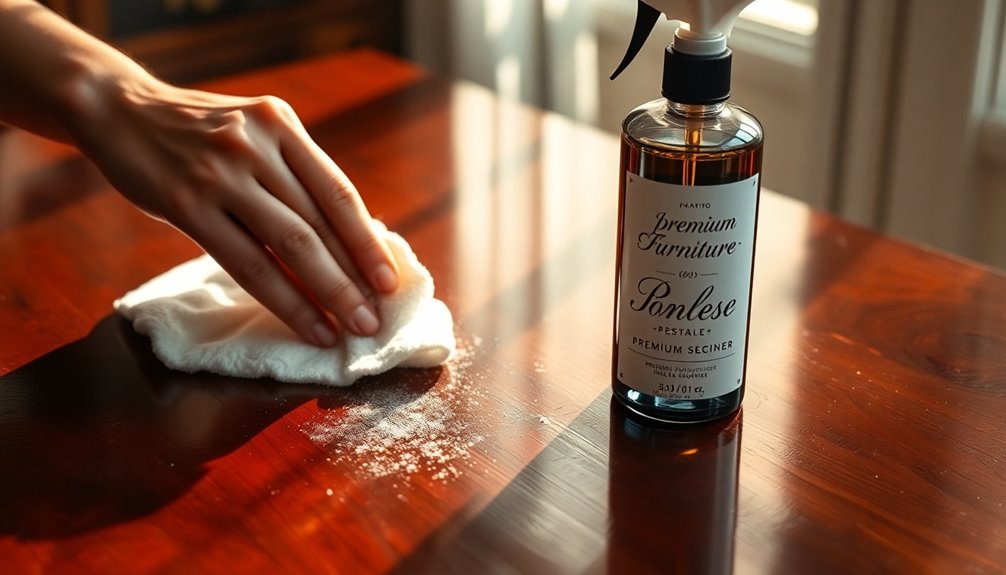
After mastering effective dusting techniques, the right cleaning solutions and polish can elevate your furniture care routine. For a natural approach, consider a vinegar and water mixture. This simple solution not only removes dust but also disinfects, thanks to the acetic acid in vinegar. You can enhance its cleaning power by adding a bit of dish soap and essential oils for a pleasant scent. Additionally, adopting mindful decluttering strategies can help you identify which items truly need regular cleaning and which can be stored away. Alternatively, a fabric softener spray works well for cleaning surfaces too.
If you prefer commercial options, Pledge Dust & Allergen Multisurface Cleaner is a great choice. It effectively removes dust, allergens, and pet dander from various surfaces, including sealed wood. Plus, it leaves a protective shine without damaging your furniture.
When cleaning, use a slightly damp microfiber cloth to trap dust more effectively. Just remember to wring it out well to avoid water damage. For added care, dusting polishes can nourish and protect your furniture while giving it a renewed look. It's also beneficial to incorporate a homemade cleaning spray that can help reduce dust accumulation in between cleaning sessions. Don't forget to regularly incorporate a soft bristle brush for those tricky crevices and cotton gloves to buff and restore shine. Regular cleaning prevents dust buildup, keeping your environment fresh and inviting.
Special Care for Wooden Furniture
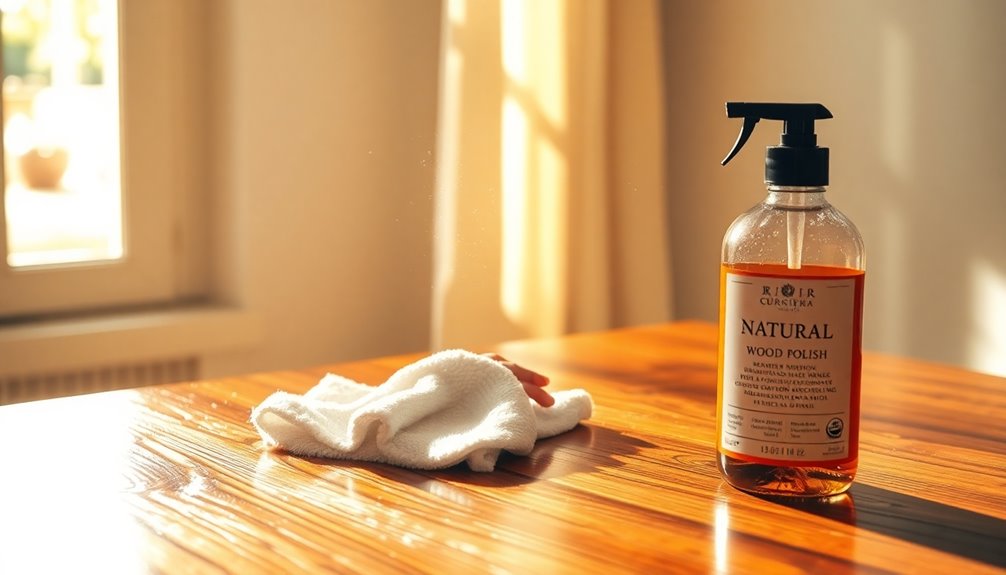
When caring for wooden furniture, it's essential to handle it with special attention to preserve its beauty and longevity. Start by removing any objects or items from the surface to ensure you have unobstructed access. Before dusting, check for stains and gently wipe them away with a soft cloth. Always test any cleaning solution in an inconspicuous area to avoid damaging the finish.
For dusting, use a microfiber cloth or lambswool duster, as they effectively attract and trap dust particles. Avoid feather dusters since they tend to spread dust around. When you dust, work from top to bottom to let dislodged dust fall onto surfaces that haven't been cleaned yet. Wipe in the direction of the wood grain to prevent scratches and streaks. Regular dusting contributes to overall furniture cleanliness, making it essential to establish a consistent routine.
Using gentle pressure is crucial, especially in intricate areas where dust can accumulate. After dusting, buff the surface with cotton gloves to restore shine and eliminate any leftover particles. Regularly dust your wooden furniture, ideally once a week, to keep it looking its best and to maintain its integrity over time.
Maintenance and Cleanup
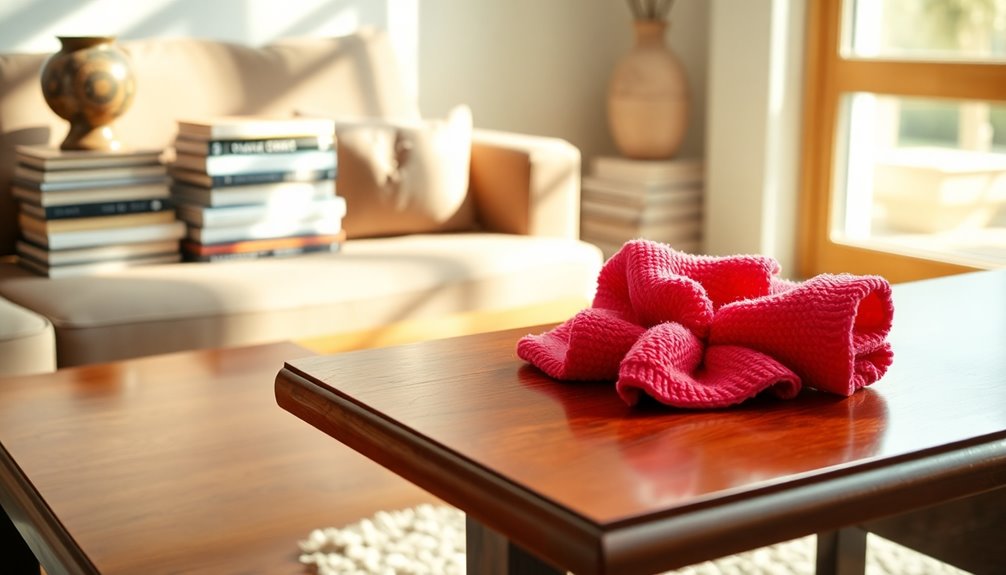
Maintaining your furniture goes beyond just dusting; it involves a comprehensive approach to keep it looking pristine and prolong its lifespan. Start by clearing all items off the surfaces to ensure thorough dusting. Before you begin, check the accessibility of the back areas and assess any dust buildup that may need attention. Measure gaps to determine if you require specialized tools, and always turn off power sources for nearby appliances. Regular home cleaning is essential for preserving the condition of your furniture.
Choose the right tools for effective dusting. Microfiber cloths capture dust efficiently, while lambswool dusters work well for broader surfaces. For hard-to-reach spots, use extendable poles and crevice tools attached to a vacuum for a deep clean. Regularly grooming pets can also help minimize pet hair around your furniture.
Adopt a systematic dusting technique by starting from the highest surfaces and working your way down. Use a damp cloth to avoid redistributing dust, and focus on high-traffic areas. Establish a regular cleaning schedule, ideally every other week, and incorporate quick touch-ups with microfiber cloths in between. Finally, vacuum or sweep around the furniture to limit dust accumulation and use adhesive lint rollers for pet hair in tight spaces. This proactive approach keeps your furniture in top condition.
Frequently Asked Questions
How Often Should I Dust My Furniture?
You should dust your furniture regularly to keep it looking fresh and to maintain a clean environment. In high-traffic areas, aim for at least once a week, while low-traffic spots can be dusted twice a month. If you've got pets or live in a pollen-heavy area, consider increasing your frequency. Don't forget hard-to-reach places; those need attention every three to six months. Staying consistent helps reduce allergens and improves your home's air quality.
Can I Use Regular Cloths Instead of Microfiber?
You can use regular cloths, but they might not be your best option. They often just move dust around instead of trapping it, and you could end up with lint and residue left behind. Plus, they might require more cleaning products and don't work as well on all surfaces. Microfiber cloths are more effective, versatile, and hygienic, so consider switching to them for a more efficient cleaning experience.
Is It Safe to Dust Electronics With a Microfiber Cloth?
Yes, it's safe to dust your electronics with a microfiber cloth. These cloths are soft and designed to trap dust without scratching surfaces. Just make sure to use them dry or slightly damp, and avoid rubbing too hard to prevent static buildup. Grounding yourself before cleaning can also help reduce any static risk. Stick to gentle motions, and your devices will stay clean and unharmed!
What Should I Do if I Have Allergies While Dusting?
If you have allergies while dusting, wear an N-95 mask to minimize inhaling dust and allergens. Use a damp or microfiber cloth to trap dust instead of stirring it up. Choose cleaning tools designed to reduce allergens, like a vacuum with a HEPA filter. Take breaks, and allow dust to settle before continuing. After cleaning, ventilate the space and consider asking someone without allergies to help if possible.
How Can I Prevent Dust From Accumulating Quickly?
To prevent dust from accumulating quickly, vacuum your home regularly and change the HVAC filter every three months. Use doormats at entryways to minimize dirt and dust from being tracked inside. Keep windows closed on windy days, and consider using an air purifier with HEPA filters to capture airborne particles. Regularly cleaning pets helps reduce dander and hair, which can also contribute to dust buildup in your living space.
Conclusion
In conclusion, keeping your furniture dust-free is simple and effective with the right tools and techniques. By preparing properly and using suitable cleaning solutions, you'll maintain the beauty and longevity of your pieces. Don't forget to give wooden furniture the special care it needs. Regular dusting not only enhances your space but also contributes to a healthier environment. So, grab your dusting tools, and make it a routine to keep your home looking its best!
